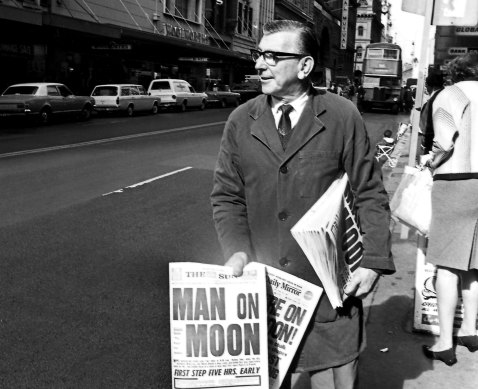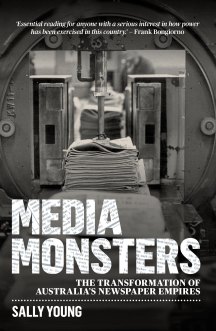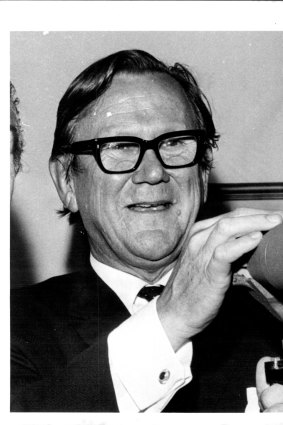By Matthew Ricketson
THE MEDIA
Media Monsters: The Transformation of Australia’s Newspaper Empires
Sally Young
UNSW Press, $49.99
Sally Young has chosen to begin and end her book about Australian media between 1941 and 1972 with the story of Colin Bednall. A journalist turned media company executive, Bednall was never such a household name as the Packers, Murdochs or Fairfaxes, who loom so large in the nation’s media history.
There is a good reason for her choice. As she wrote at the beginning of her previous book, about the rise of Australia’s newspaper empires between 1803 and 1941: “Newspapers have found it very difficult to tell the truth about themselves.”

A newspaper seller pictured following the Apollo 11 moon landing in July 1969.Credit:
Bednall did tell the truth about the news industry in an autobiography written in the early 1970s but never published. It has languished among his private papers in the National Library of Australia’s archives. After working at senior levels in the Herald & Weekly Times under Keith Murdoch and as managing director of Frank Packer’s GTV-9 in Melbourne, Bednall fell out with the latter over cost-cutting and “telephone calls from the boardroom to disreputable persons”.
He was blacklisted, a victim of a longstanding informal agreement among media owners to punish those seeking salary increases elsewhere or, in Bednall’s case, for being “annoyingly independent, and principled”, writes Young.

Credit:
The scales fell from Bednall’s eyes. He saw how the country’s media proprietors had amassed power unparalleled in the world and had wielded it ruthlessly, to protect or advance their commercial interests and to influence government policies and the outcome of elections.
He wrote that a prime minister needed to make only three telephone calls to have the Australian newspaper groups marshal “their entire resources” and spread a message around the country, by print and on air, in a matter of hours or days. Bednall’s description of them as “media monsters” gives Young her title.
He came to regret his role in helping the newspaper proprietors manipulate the process of government allocation of the first commercial television licences in the early 1950s. First, they stalled the introduction of a new medium that had been invented in the 1920s, first broadcast by the BBC in Britain in 1936 and broadcast commercially in the US since 1947.
Then, when they saw how their US counterparts had miscalculated by not buying outlets for a swiftly profitable medium, they manoeuvred to take control by installing Bednall (with government agreement) as a member of a royal commission into television that recommended newspaper companies were best placed to be granted the new licences.

Colin Bednall, the media executive who fell out with Frank Packer.Credit:
The story of how television came to Australia has been told before, but Young, a political scientist, makes the reader attend to the corrupted political forces at work. Throughout this well-researched, crisply written book, she draws on an impressive array of sources, ranging from previously published accounts and academic studies to private letters between media executives and close reading of newspapers aided by the priceless research tool Trove.
Media Monsters covers the period from early in the Second World War when daily newspapers in Australia were still the primary news medium – more than 2.6 million newspapers were sold daily in a population of 7.5 million. Radio was young, and it was not until the war that the ABC, established in 1932, was able to develop its own independent news service, primarily because the newspaper proprietors, led by Murdoch, lobbied government to restrict the ABC and protect their afternoon sales.
Television quickly became the most popular medium, which would have worried the newspaper magnates more had they not become the main holders of commercial TV licences, which as Roy Thomson, the owner of The Times and other papers in Britain, said, were a licence to print money.
The book ends with the election of the Whitlam Labor government in 1972, by which time, Young writes, even former long-serving Liberal prime minister Robert Menzies realised proprietors had amassed enormous power across print and broadcast media despite his and other governments’ efforts.
A clear picture emerges in the book of newspaper media proprietors who acted as a law unto themselves (Frank Packer), surveyed their territory with seigneurial indifference (Sir Warwick Fairfax) or energetically and inventively grew their holdings into a burgeoning empire (Rupert Murdoch).
While there had been 16 proprietors of the country’s metropolitan daily newspapers in 1945, there were only three in 1972 after Frank Packer sold The Daily Telegraph to Rupert Murdoch. This was before the Hawke Labor government’s notorious cross-media ownership laws of 1986 that led to further concentration of media ownership, benefiting especially Murdoch and Kerry Packer, Frank’s son.
For those, like me, who began working in the media in the 1980s, the cross-media ownership laws were a seismic event, but as Young documents clearly, it’s more accurate to see them as a continuation, maybe a culmination, of a pattern established decades before.
Whether and how Young will continue her researches into the current day will be fascinating to see. Just because the legacy media companies’ business model has been waylaid by the big tech companies does not mean questions about abusive media power have faded.
Quite the contrary: recall the recent revelations from the Fox News-Dominion lawsuit that was settled only after News Corp showed itself to have cared less about truth than knowingly continuing to broadcast lies to retain an audience worth more than $US1 billion a year.
Matthew Ricketson is a professor of communication at Deakin University and co-author of Who Needs the ABC?
The Booklist is a weekly newsletter for book lovers from books editor Jason Steger. Get it delivered every Friday.